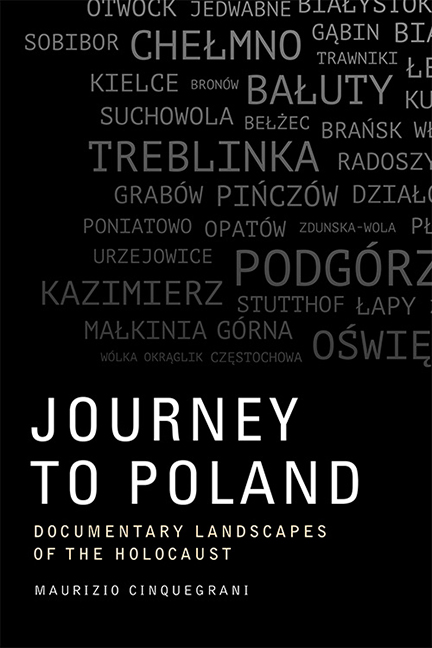Book contents
- Frontmatter
- Contents
- List of Figures
- Acknowledgements
- Dedication
- Prologue: Space, Time and the Holocaust
- 1 Countryside, Shtetl, City: The Murders of Mazovia, Jedwabne and Kielce
- 2 Conflicting Memories in the Shtetlekh Gąbin, Suchowola, Brańsk and Luboml
- 3 The Marketplaces of Postmemory in the Shtetlekh Eishyshok, Delatyn, Opatów, Zdunska Wola, Urzejowice and Pińczów
- 4 A Tale of Two Cities: Warsaw and Kraków
- 5 Another Tale of Two Cities: Lviv and Łódź
- 6 A Tale of Two Cities of Death: Treblinka and Oświęcim
- Epilogue: New Routes
- Bibliography
- Filmography
- Index
Epilogue: New Routes
Published online by Cambridge University Press: 10 November 2020
- Frontmatter
- Contents
- List of Figures
- Acknowledgements
- Dedication
- Prologue: Space, Time and the Holocaust
- 1 Countryside, Shtetl, City: The Murders of Mazovia, Jedwabne and Kielce
- 2 Conflicting Memories in the Shtetlekh Gąbin, Suchowola, Brańsk and Luboml
- 3 The Marketplaces of Postmemory in the Shtetlekh Eishyshok, Delatyn, Opatów, Zdunska Wola, Urzejowice and Pińczów
- 4 A Tale of Two Cities: Warsaw and Kraków
- 5 Another Tale of Two Cities: Lviv and Łódź
- 6 A Tale of Two Cities of Death: Treblinka and Oświęcim
- Epilogue: New Routes
- Bibliography
- Filmography
- Index
Summary
Isuchar Moshe Szwarc was born near the market square of Zgierz, a town located just north of Łódź, in February 1859. He was considered one of the most erudite and wisest men in the community, and on his eightieth birthday in 1939 the Jewish press in Poland published numerous articles in his honour. A few months later, the Nazis burnt his library while he collapsed and died of a heart attack. Nobody could attend Szwarc's funeral, as he was hastily buried by the Red Cross (cf. Shtockfish, Kanc and Fisher, 1975–86: 486). Zgierz was renamed Görnau by the Nazis between 1943 and 1945, and its former rynek is now named after Pope John Paul II. Over seventy years after the death of Szwarc, the journey to Łódź undertaken by Holocaust survivor Natan Grossmann in Tanja Cummings’ documentary Linie 41 (Line 41, 2015) would begin on this square, the place where in 1940 the Jews of Zgierz were assembled before being deported to the ghettos in Głowno and Bałuty. While in Zgierz, Grossmann identifies the house where he lived with his family and which they rented from a wealthier Polish family. From this location the survivor travels to Łódź, where his parents perished and from where his brother was deported to Chełmno, and visits various sites in the city, including the rynek and the courtyards of Bałuty, Zielna Street, Tokarzewskiego Street, Radegast Station, Staromiejski Park and the Jewish cemetery. Towards the end of Line 41, Grossmann observes ironically that he was fortunate to be deported to Birkenau because the alternative, Chełmno, offered no chance of survival. Indeed, only a handful of people survived this camp, including Lanzmann's witness Szymon Srebrnik; Line 41 returns to the locations of Shoah in Chełmno and repeats Lanzmann's car ride from the church where the Jews were imprisoned to the Rzuchow forest, where they would arrive already dead inside the gas vans. As Cummings’ film suggests, thirty years after the release of Shoah the cinematic landscapes of Poland are still informed by repetitive itineraries across the landscapes where the Jews were exterminated.
- Type
- Chapter
- Information
- Journey to PolandDocumentary Landscapes of the Holocaust, pp. 179 - 183Publisher: Edinburgh University PressPrint publication year: 2018



